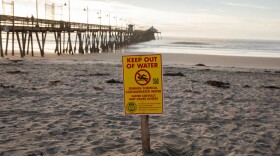Scientists around the country, including some in San Diego, are working with the U.S. Navy to tackle an age-old problem known as biofouling. It's the accumulation of marine organisms on the bottom of a boat.
Every boater's problem
This marine gunk can be seen from the surface, as algae and crustaceans float around the edge of a boat. But divers Brian Hall and Jarryn Hallare know that biofouling can get much worse. At a pier in Mission Bay, they zip into their wet suits and equip themselves with sponges. In the tight space between a boat and the dock, they plunge into the water.
The bottom of this boat is caked with heavy, crusty white tube worms. And these two divers have been hired to scrub them away. Hall is the owner of a boat hull cleaning business in San Diego called Dockside Divers.
"We’ll end up with oysters and clams and muscles that grow on these boats, it starts with a slime or small algae and then progresses to the harder, more complex growth," Hall said.
Hall says the average boat owner can spend around $1,500 a year just to get rid of these invasive and heavy marine species. And if the boat owners do nothing, the build up still costs them money. That's because this pile-up decreases fuel performance.
"The new boater is often shocked," Hall said. "They purchase a new boat for the first time and three or four months later we get an emergency call. And they’ve got a forest down there and they try to go to Catalina ... and realize they’re going at half the speed they could be," Hall said.
Biofouling isn’t new. Since ancient times, boat owners have used paints with toxic materials like tin to prevent marine life from building up.
Some of these paints have been banned because they harm marine life. The need for solutions has caught the attention of not only boaters, but also scientists.

Stopping biofouling naturally
In his lab on the San Diego State University campus, marine microbiologist Nicholas Shikuma pointed to a petri dish bubbling with water. Inside is bacteria and a small colony of white, cylindrical tube worms. He is looking at how they interact.
"It turns out that lots of these marine organisms decide where to stick to the bottom of ships based on whether there’s friendly bacteria on the bottom," Shikuma said.
For years, Shikuma has been investigating why this bacteria attracts the sticky material. And he’s figured out one essential reason.
"The bacteria produced this syringe-like structure that injects stimulatory protein into the tube worm baby and then causes it to stick to the bottom of the ship," Shikuma said.
Picture a stinger on a bumble bee. The insects use stingers to repel enemies, and so do bacteria on the bottoms of boats. But, the problem is tube worms like getting stung. So, they stick around to get more.
Shikuma said in the future these bacteria could be genetically modified to be less attractive to tube worms. Though, he said the idea is still theoretical right now.
Navy coming closer to a solution
But, he’s not the only scientist coming up with ideas. In fact, the U.S. Navy has been funding labs across the country to address the issue of build-up on ship hulls, including Shikuma’s.
Linda Chrisey, who's with the Office of Naval Research, said biofouling costs the Navy around $200 million a year in lost fuel and cleaning.
"There are now coatings available that have less toxins in them, which is a positive for the environment, and we believe as we continue to do the research it will get better," Chrisey said.

The Navy uses paints that are less toxic than before. But, these paints still have some heavy metals like copper and the paint doesn’t last long.
"That’s why studying their biology is important. If we can recognize what features of a surface make that an unappealing surface, we’re halfway there in terms of finding a solution that’s friendly to the environment and can help the Navy," Chrisey said.
The research program has been going on for a while, and will continue. But, with discoveries like those from Shikuma, she thinks in the next decade the Navy will come closer to developing an effective commercial product. One that’s based on nature.
"The fact that an organism like the tube worm would come to rely on a bacterium to develop is pretty cool and interesting," Chrisey said.
And back at the pier, boat cleaner Hall isn't worried that the research will put him out of business. That’s because boats require care in a lot of different ways.
"Anything that helps prevent biofouling is a good thing ultimately," Hall said.
Hall said finding a solution for a centuries old problem may encourage more people to get a boat. And it means less toxic chemicals for the marine environment.







